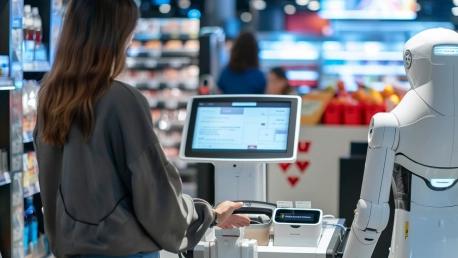Retail automation is poised for substantial growth over the next few years, driven by technological advancements and changing consumer behaviors. The adoption of artificial intelligence (AI) and machine learning (ML) in the retail sector is fueling this progress, significantly enhancing operational efficiency and customer experiences. However, stakeholders must remain vigilant about significant challenges related to privacy and security to fully capitalize on this transformative phase in retail.
The Driving Forces Behind Retail Automation Growth
Rise of Contactless Payments and Big Data Management
The increasing adoption of contactless payment solutions is a major contributing factor to the growth of retail automation. Consumers’ preference for quick, easy, and hygienic transaction methods has urged retailers to integrate these systems. With the rise of the COVID-19 pandemic, the push for contactless payments has only intensified, making this technology a requirement rather than a luxury for modern retailers. Contactless payment technologies, including mobile wallets and NFC-enabled cards, offer customers a seamless, touch-free experience that aligns with current health and safety priorities. Retailers benefit from these solutions through faster transaction times, reduced waiting lines, and enhanced customer satisfaction, thereby driving overall market growth.Concurrently, the emergence of big data management trends in retail assists businesses in capturing crucial data on customer demographics, payment preferences, and buying behaviors. Retailers can harness this data to personalize shopping experiences, optimize inventory management, and predict future sales trends. Big data analytics allows for deeper customer insights, enabling tailored marketing campaigns and loyalty programs that resonate more effectively with consumers. As retailers continue to prioritize data-driven decision-making, big data management solutions are becoming indispensable, further propelling the retail automation market forward.
Shift Towards Cloud-Based Solutions
The transition to cloud-based solutions allows for seamless data accessibility across various platforms, an essential feature for modern retailers who operate in multiple locations or offer omnichannel shopping experiences. By integrating more back-end software in the cloud, retailers can ensure that customer and product information is readily available and consistently updated across all touchpoints. Cloud technology enhances back-end operations, such as inventory management, supply chain coordination, and customer relationship management, providing a more cohesive and efficient business model.Cloud-based Point of Sale (POS) systems, in particular, are transformative for the retail sector. These systems enable retailers to manage sales, payments, and customer data more efficiently and accurately. They offer features like real-time inventory tracking, automated sales reporting, and integrated loyalty programs, which help retailers streamline their operations and enhance customer service. Moreover, cloud-based POS systems support remote access, allowing managers to monitor and manage stores from any location. This flexibility is increasingly important in today’s retail environment, where agility and responsiveness are key to staying competitive.
Technological Innovations Shaping Retail
Role of AI in Demand Forecasting and Customer Experience
Artificial Intelligence is revolutionizing retail, with a particular focus on demand forecasting and personalized marketing campaigns. Predictive analytics powered by AI enables retailers to anticipate customer needs accurately, thereby optimizing inventory levels and reducing wastage. By analyzing patterns in historical sales data, weather forecasts, social media trends, and even local events, AI can forecast demand with unprecedented accuracy. This capability allows retailers to ensure that popular items are always in stock, reducing lost sales opportunities and minimizing excess inventory that can tie up capital and storage space.Personalized marketing, driven by AI, creates tailored shopping experiences that enhance customer satisfaction and loyalty. AI algorithms analyze customer behavior, purchase history, and preferences to deliver highly targeted marketing messages and product recommendations. These personalized interactions increase the likelihood of sales and encourage repeat purchases. Furthermore, AI can identify emerging trends and customer segments, enabling retailers to adjust their marketing strategies proactively. As a result, retailers can offer more relevant promotions and improve the overall shopping experience, which contributes to higher customer retention rates.
Automation in Logistics and Warehousing
Automation technologies such as interactive chat programs, logistics management systems, and automated conveyor systems are playing pivotal roles in transforming logistics and warehousing operations. These technologies optimize inventory management, distribution, and staffing, ensuring that goods move efficiently through the supply chain. Automated logistics management systems provide real-time visibility into inventory levels, order status, and shipment tracking, allowing retailers to make informed decisions and respond quickly to changes in demand or supply chain disruptions.Robotics is particularly impactful in warehouses, where it boosts operational efficiency by automating various tasks, from inventory management to order fulfillment. Autonomous mobile robots and automated guided vehicles (AGVs) can transport goods within the warehouse, reducing the need for manual labor and increasing accuracy and speed. These robots can work around the clock, further enhancing productivity and throughput. In addition, automated storage and retrieval systems (AS/RS) optimize space utilization and ensure that items are stored and retrieved with precision, reducing the likelihood of errors and improving overall efficiency.
Market Segments and Key Players
Segmentation by Type and End-User Categories
The retail automation market is segmented into various categories, including POS systems, barcode and RFID, camera systems, and other automated technologies. These segments represent diverse facets of retail automation, each contributing uniquely to enhancing retail operations. For instance, automated checkout solutions like self-service kiosks and smart carts improve customer convenience and reduce labor costs, while advanced surveillance systems bolster security and reduce shrinkage.In terms of end-users, the main categories include supermarkets, hypermarkets, single-item stores, fuel stations, and retail pharmacies. Supermarkets and hypermarkets are particularly notable, as their large-scale operations benefit immensely from automation in areas like inventory management, checkout processes, and customer service. Single-item stores, such as boutique shops and specialty retailers, use automation to streamline operations and offer specialized customer experiences. Fuel stations deploy automated solutions for efficient fuel dispensing and payment processing, while retail pharmacies utilize automation for prescription management and inventory control.
Importance of POS Systems
POS systems are crucial in retail automation, combining hardware and software to manage sales transactions efficiently. These systems enhance inventory management by providing real-time updates on stock levels, enabling retailers to reorder products promptly and avoid stockouts. Accurate reporting is another key advantage, as POS systems generate detailed sales reports that help retailers analyze performance, identify trends, and make informed decisions.POS systems also improve customer service by speeding up the checkout process and integrating with loyalty programs to offer personalized rewards. Modern POS systems support various payment methods, including contactless and mobile payments, meeting the diverse preferences of today’s consumers. Additionally, cloud-based POS systems offer the flexibility of managing multiple store locations from a central platform, making them indispensable for chain stores and franchises.
Role of Barcode and RFID Technology
Barcode and RFID technologies are vital for inventory tracking and management, playing a significant role in retail automation. Barcodes provide a simple yet effective way to track inventory items through the supply chain, from manufacturing to the point of sale. Scanning barcodes at different stages of the supply chain ensures that products are accurately accounted for, reducing manual errors and streamlining operations.RFID technology takes inventory management a step further by enabling real-time tracking and greater data capture capabilities. RFID tags can be scanned wirelessly and from a distance, allowing for faster and more efficient inventory counts. This technology also provides enhanced visibility into inventory movements, helping retailers maintain accurate records and optimize stock levels. By leveraging barcode and RFID technologies, retailers can improve inventory accuracy, reduce shrinkage, and enhance overall supply chain efficiency.
Geographical Trends and Regional Insights
APAC Region’s Rapid Growth
The Asia-Pacific (APAC) region is expected to exhibit significant growth in retail automation due to rapid technological advancements and increased adoption of automation solutions. Market dynamics in this region are driven by a growing middle class, increased consumer spending, and a strong appetite for innovative technologies. As urbanization continues and disposable incomes rise, consumers in APAC are demanding more convenience and personalized shopping experiences, pushing retailers to adopt advanced automation technologies.Countries like China, India, and Japan are at the forefront of this growth, investing heavily in retail automation to enhance customer experiences and operational efficiencies. The widespread adoption of e-commerce in the APAC region further fuels the demand for automated solutions in logistics and warehousing. Retailers in this region are embracing technologies like AI, ML, robotics, and cloud computing to stay competitive and meet the evolving expectations of tech-savvy consumers.
North America and Europe: Established Markets
North America and Europe remain key markets for retail automation, characterized by established retail infrastructures and a strong inclination towards integrating advanced technologies. Retailers in these regions have been early adopters of automation, leveraging it to improve operational efficiencies, enhance customer experiences, and stay ahead of the competition. The presence of major technology companies and innovation hubs in these regions also contributes to the rapid development and deployment of retail automation solutions.In North America, the retail sector’s focus on improving customer engagement, optimizing supply chain operations, and ensuring data security drives the adoption of automation technologies. Similarly, in Europe, regulatory environments and stringent data protection laws necessitate robust automation solutions that comply with legal requirements while providing meaningful business insights. As these markets continue to mature, retailers are likely to explore more sophisticated applications of AI, ML, and robotics to maintain their market leadership.
Addressing Challenges in Retail Automation
Cybersecurity Concerns
As retailers increasingly rely on automation, the importance of robust cybersecurity measures cannot be overstated. Protecting consumer data and preventing breaches are critical for maintaining user confidence and ensuring the smooth operation of automated systems. The growing reliance on digital transactions and the integration of IoT devices in retail environments create numerous entry points for potential cyber threats. Cybersecurity becomes paramount, as breaches can lead to significant financial losses, legal repercussions, and damage to brand reputation.Retailers must implement comprehensive cybersecurity strategies that include encryption, multi-factor authentication, regular security audits, and employee training. These measures help safeguard sensitive information, such as payment details and personal data, from unauthorized access and cyberattacks. Additionally, retailers should invest in advanced threat detection and response systems to quickly identify and mitigate potential security incidents.
Balancing Innovation with Security
Retail automation is set for remarkable growth in the coming years, propelled by technological innovations and evolving consumer behavior. The integration of artificial intelligence (AI) and machine learning (ML) is at the forefront of this transformation, leading to significant improvements in both operational efficiency and the customer experience. Retailers are leveraging these technologies to streamline supply chains, personalize shopping experiences, and optimize inventory management, among other benefits.AI and ML allow for predictive analytics, helping retailers forecast demand and manage resources more effectively. These technologies can also enhance customer engagement through personalized recommendations and targeted marketing, leading to higher customer satisfaction and loyalty. Automated checkout systems and advanced customer service bots further elevate the shopping experience by reducing wait times and resolving issues promptly.However, as retailers become increasingly dependent on these advanced technologies, they must address substantial challenges related to data privacy and security. Safeguarding sensitive customer information and ensuring compliance with privacy regulations are crucial for maintaining consumer trust. Therefore, stakeholders in the retail industry need to be proactive about implementing robust security measures to mitigate risks and fully capitalize on the benefits of retail automation without compromising customer trust.








